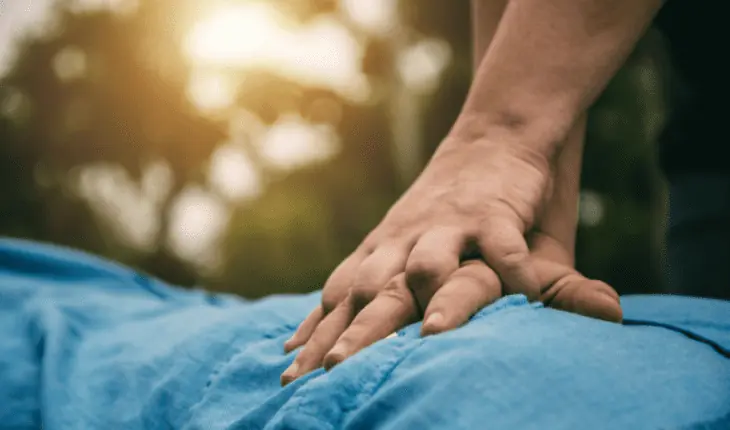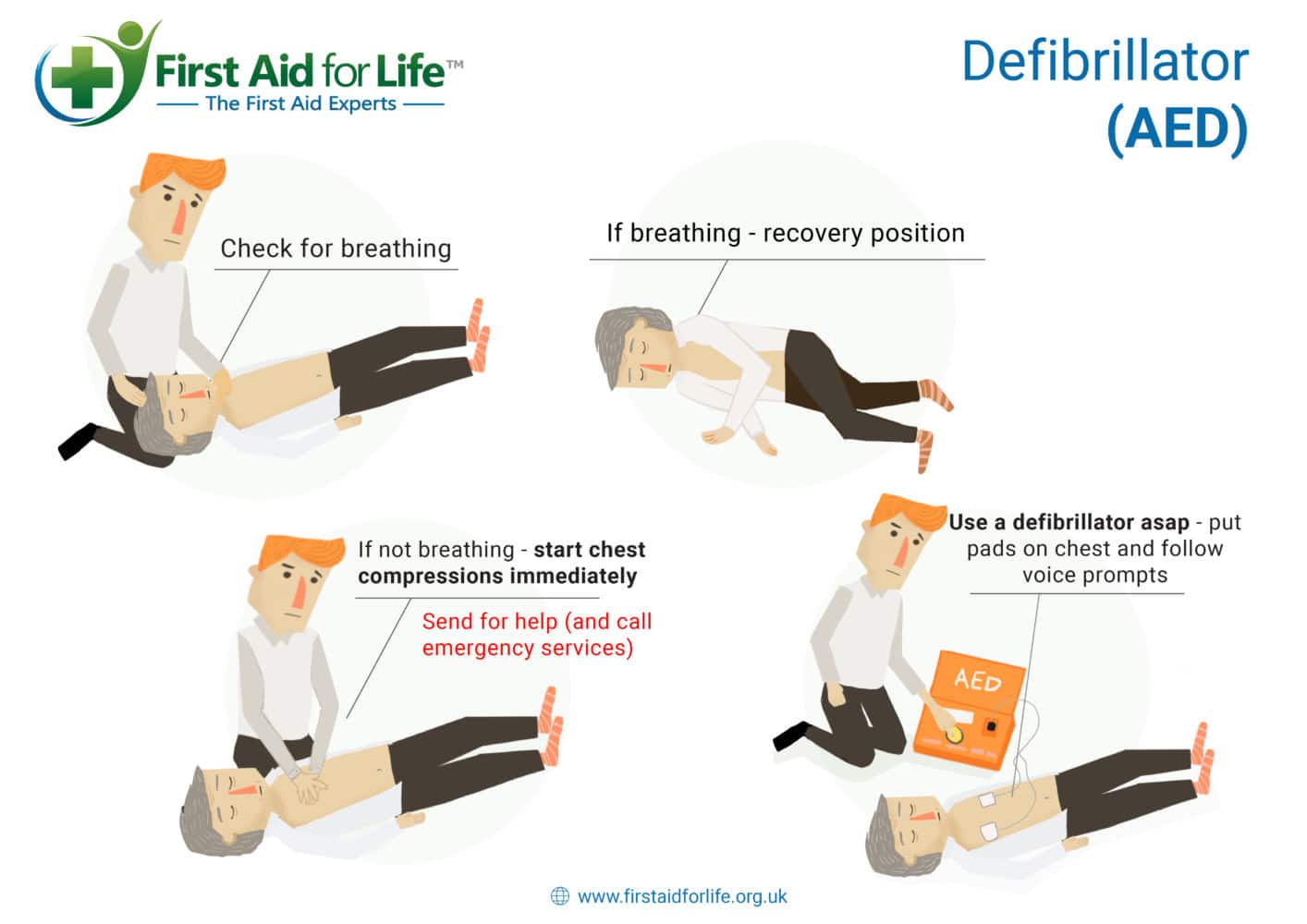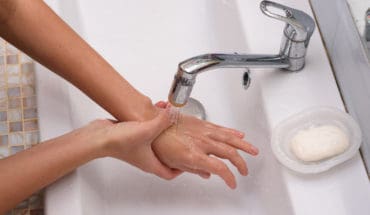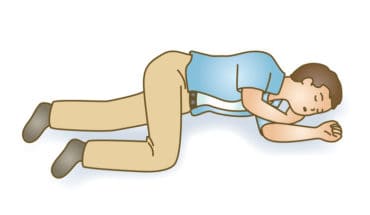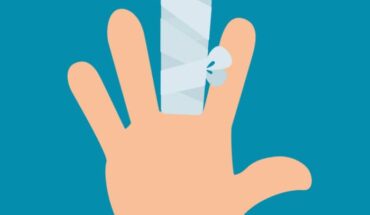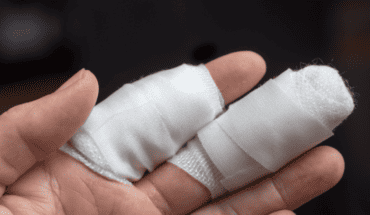The UK survival rates radically lag behind the rest of Europe. It is hoped that adding first aid to the curriculum in English Schools will help. However, the key development is that more people undertake some form of practical or online first aid training and are able to start CPR as soon as possible if someone collapses and stops breathing.
When to give CPR
In the UK alone, approximately 30,000 people suffer an out-of-hospital cardiac arrest each year. Effective bystander CPR and the use of a defibrillator can more than double a casualty’s chance of survival. If someone is unconscious and not breathing it is imperative that you open their airway and commence CPR as quickly as possible. If you have access to a Defibrillator (AED), you should deploy that as quickly as possible and call for an ambulance.
In the case that the casualty is unconscious but they are still breathing, you should put them into the recovery position and monitor them closely to make sure they continue to breathe.
Click here to learn how to put someone into the recovery position.
How to perform CPR on an adult –
Adults with a Cardiac Arrest generally retain 3 or 4 minutes worth of residual oxygenated blood in their system. If someone is pushing hard and fast on their chest, to pump that blood around their body, this can keep their heart and lungs supplied with oxygenated blood for a few minutes and buy them some time.
However, after 3 or 4 minutes (without being given breaths) they will start to run out of oxygenated blood. Therefore, to keep the casualty oxygenated and give them the best chance of survival, the casualty should also receive breaths:
- Place the heel of your hand on the centre of the person’s chest, then place the other hand on top and press down by 5-6cm at a steady rate of 100 to 120 compressions per minute.
- After every 30 chest compressions, give two rescue breaths.
- Sufficient breaths should be given to inflate the chest.
- Deploy a defibrillator as quickly as possible.
CPR on a Child
Children are more likely to have experienced a respiratory arrest and they are also unable to retain oxygen in their system with the same efficiency as adults. Therefore, when resuscitating a child, they should initially receive 5 rescue breaths – tilt their head and lift their chin to open their airway and then breathe into them sufficiently for their chest to rise.
This should be followed by 30 chest compressions, pushing down on the chest by about a third and pushing hard and fast.
Get an ambulance on the way and then continue: 2 breaths: 30 compressions….
What to do if your baby is unconscious and not breathing
As with the adult and child advice; first check Danger, Response, open their Airway and check for Breathing – If you think they are not breathing properly (less than 2 breaths in a 10 second period), start CPR (Cardio Pulmonary Resuscitation)
Carefully tilt the head and lift the chin to roughly a horizontal position to take the tongue off the back of the airway then give 5 rescue breaths to re-oxygenate them. Babies and children are much more likely to have had a breathing problem first resulting in a respiratory arrest – their heart will stop later.
Seal your mouth around their mouth and nose (if you can fit your mouth over both) and blow into them gently with a puff of your cheeks (their lungs are about the size of a teabag – so don’t breathe too hard).
If they start to gurgle when you breathe into them, briefly turn them onto their side and empty any vomit from their mouth, before continuing with the breaths.
Push down by a third of their depth with two thumbs or fingers
Push hard and fast on the centre of their chest – roughly between the nipples at a rate of about 120 beats per minute – roughly 2 per second
After about 30 compressions…you will need to give them 2 more breaths and then continue with the compressions again. 30:2:30:2:30:2…
Keep going
When you push on the chest – you are being the heart
When you breathe into them – you are being the lungs
If you are on your own, you should perform 1 minute’s CPR before phoning for an ambulance (5 breaths, 30:2, 30:2 is about a minute). Continue until the paramedics arrive.
For full article click here on how to help an unconscious baby.
Why defibrillators save lives
It is vital that anyone who is unconscious and not breathing, receives immediate and appropriate treatment – using CPR and a defibrillator. Frighteningly figures from the British Heart Foundation show that only one in ten victims survive following a cardiac arrest
Our survival rate is considerably lower than that in Scandinavian Counties where there is a far higher importance paid to the education and training of school children and the general population to ensure they are sufficiently skilled and equipped to be able to help immediately someone collapses.
Defibrillators (AEDs), combined with effective CPR, save lives. If someone collapses and is unconscious and not breathing, their chances of survival in the community are only about 6%. However, if they receive quality CPR and a defibrillator is deployed within 3 minutes and they are in a schockable rhythm, the chances of survival jump to 74%.
How a defibrillator works:
An AED is an Automatic External Defibrillator – which means that it automatically detects if someone is in a shockable rhythm and it speaks to you, to tell you what to do.
Defibrillators do not jump start the heart like jump starting a car; they stop it like rebooting a computer. Ultimately this allows the individual heart cells to recharge simultaneously and the pacemaker in the heart to hopefully restart it in a normal rhythm.
The defibrillator administers a shock to stop the heart if it is in an abnormal but shockable rhythm. Enabling the heart’s own system to reboot and hopefully restart in sinus rhythm (normal beat).
AEDs are used in addition to CPR to save the lives of those suffering cardiac arrest.
Research has shown that deploying a defibrillator within 3–5 minutes of collapse can produce survival rates as high as 50–70%.
How to use an AED
Click the heading above to watch a video on how to use an AED.
Hundreds of people are alive today entirely due to the prompt and appropriate use of a defibrillator. For every minute’s delay in deploying a defibrillator, the odds of survival reduce by about 10%.
Once activated, the AED will talk to you and tell you what to do.
Defibrillators are designed to be as easy as possible to use. They will tell you how to use them so even if you’ve never been trained you should try your hardest.
- Firstly, activate it. Machines vary but this is usually done by opening the lid or pressing an obvious button.
- If you aren’t alone, someone should continue CPR, whilst the other attaches the leads to the AED (if necessary).
- Dry the chest (and use the razor to shave if excessively hairy).
- Peel the pad off the backing one at a time and place onto the dry chest according to the diagram on the packet.
- Place one pad below the casualty’s right collar bone.
- Position the other on the casualty’s left-hand side, over their lower ribs.
- The AED will analyse the heart rhythm.
- Stop CPR when instructed by the AED.
- Ensure no one is touching the casualty.
If a shock is advised:10. Check the whole length of the casualty to ensure no one is touching them.
11. Then shout loudly: ‘stand clear’.
12. Press the flashing shock button as directed (fully automated AEDs will do this automatically once a shock is advised).
13. Continue with CPR as directed.
14. Keep going with 30 compressions to 2 breaths.
15. Do not stop to check them unless they begin to regain consciousness and start breathing normally.
16. The machine will reassess their heart rhythm every 2 minutes and advise another shock if indicated.
If no shock is advised:• Continue with CPR and follow prompts
• Keep going until help arrives. Stop CPR if the casualty begins to regain consciousness and starts to breathe normally.
• The machine will reassess their heart rhythm every 2 minutes and advise a shock if indicated.
To give CPR: 30 compressions, then 2 rescue breaths. Repeat.
If there is more than one rescuer swap every couple of minutes.
Defibrillators dramatically improve a casualty’s chance of survival and are now widely available for the general public to use. However, we need far more in the community and work-places to be able to have the major improvements on survival from cardiac arrest that is seen in other countries such as Sweden.
What should you do if you witness someone having a sudden cardiac arrest?
- Call 999 – or ideally get someone else to make the call and report back to you. You can also put the phone on speaker so you can start CPR without delay.
- Begin CPR
- Get someone to locate a defibrillator (AED) and bring it to you immediately.
- If you are using a defibrillator on a child, ideally you will use paediatric pads, or the paediatric setting. If there is no setting and only adult pads – you can use one pad on the front of their chest and one on the back for children over the age of one.
- In the case that there are no paediatric pads and no special setting and the child is under 1 year, keep doing CPR and get advice from the paramedics – they will usually advise you not to use the defibrillator.
With any luck, there will be one near you. For maximum accessibility, they are most common in public places such as train, bus and tube stations, shopping centres, airports, dentists, GP Practices and leisure centres there are apps such as Heartsafe which can help locate the nearest AED.
Defibrillators are extremely easy to use and you cannot do any harm to an unconscious casualty by using one. If someone is unconscious and not breathing they need your assistance fast.
It is vital to act fast.
Only 40 per cent of bystanders in the UK who witness a cardiac arrest perform CPR
Research by the British Heart Foundation reveal that that only four in ten bystanders performed CPR, and that 62 per cent of British adults admitted to being worried about what to do if someone collapsed in front of them after suffering cardiac arrest.
Defibrillators make all the difference following sudden cardiac arrest, but more still needs to be done to increase awareness.
- What is a seizure? - 13th March 2025
- Febrile Convulsions and Seizures in Children - 13th March 2025
- Why women are less likely to receive CPR or survive cardiac arrest - 6th March 2025

